Seven Senses In Toddlers
Sense is the process of acting against the information we collect from our surroundings. In simple words, it is the awareness of something. Babies start sensing the world on the very first day of their birth. They are the most curious little fellows who always try to keep exploring. Sensory integration plays a very important role in a child’s overall health and well-being. It’s the basis of kids’ perceptions and learning.
There are Seven Sensory Skills in Toddlers
1 Sight Sense (Vision)
2 Auditory System (Hearing)
2 Tactile System (Touch)
4 Gustatory System (Taste)
5 Olfactory System (Smell)
6 Sense of Body Awareness and Position (Proprioception)
7 Awareness of Movement, Balance, and Coordinate (Vestibular)
Sight Sense
It is the ability of the eye to see color and movement through the retina. This is how we recognize the environment around us. The information is transferred to our body, and the body then creates responses and responds to the environment. This builds our vocabulary and language skills by naming things.
Children have the same vision as adults. Following the toy with his eyes is the best exercise to strengthen the eye muscles. By rolling their eyes, they learn to get their eyes to work together.
Auditory Sense
It is the ability to hear. Sound is a vibration in the outer and inner ears that produces noise. The receptors in the ears picked up the sound that was carried on the airwaves.
If a child can listen and hear properly, He can be better at his intellectual learning development. Those who do not hear properly get depressed and frustrated. That’s why it is the most crucial skill for toddlers. Help your child determine the direction and distance of the sound.
Tactile Sense
It is the ability of the skin to interpret information coming to the body. The skin receptors receive several distinct sensations and transfer them to the brain. The brain then recognizes the temperature, vibration, pressure, pain, and other sensations.
Children need a constant touch of love, as it not only helps them in their emotional development but is also very important for their well-being.
Gustatory Sense
It is the sense of taste in the mouth through the tongue. The buds on the tongue sense the taste. There are four different types of tastes: Sweet, Sour, Bitter, and Salty. It helps us determine what to eat and what to drink. It also helps us digest food.
Toddlers often put objects in their mouths in order to learn the sense of taste, but it’s harmful. Provide colorful and tasteful food to them.
Olfactory Sense
It is the ability of the nose to smell. There are millions of tiny hair cells in the nose. Each cell is connected to an olfactory neuron or nerve cell, which gives signals to the brain. The brain then transfers these signals, and the smell is processed and experienced. This sense is directly related to memory.
A smell can alert us to danger. Children have a very strong sense of smell. They can smell danger.
Proprioception Sence
Proprioception is the ability to understand the relationship between your body parts. It is the body’s awareness that allows it to sense itself. It allows us to understand the position, location, and movement of the muscles and joints. Pushing, Pulling, Stretching, Climbing, and Squeezing stimulate the sense of proprioception.
A message and a hug can keep a child calm, soothed, focused, and alert. It is also responsible for regulating the emotions of a child.
Vestibular Sence
It is the ability of a body to move and balance. It is located in the inner ear of the body. The vestibular system is responsible for how our body and brain react to gravity and the objects around us. It not only determines the speed and direction of movement but also maintains head and body posture.
Children learn to crawl, sit, and walk through their sense of gravity through the vestibular system. They make lots of movements to stimulate this system.
Sensory Processing Disorder
Many children face sensory disorders in their early lives, but as parents, it’s our responsibility to monitor and understand our child’s behavior. Sensory Processing Disorder (SPD) is a condition in which a child’s brain cannot recognize sensory information like taste, smell, sight, and sound and sometimes lacks emotions. There may be two kinds of situations a child can face (SPD). Hypersensitive or Hypersensitive. Monitor their conditions with some clinical tests and help them heal with different exercises and therapies.
In conclusion:
The world of a toddler is a rich tapestry of sensory experiences. Each of the seven senses in toddlers—sight, sound, touch, taste, smell, proprioception, and vestibular—contributes to a complex and fascinating journey of discovery. As parents and caregivers, it is essential to provide a stimulating environment that nurtures and challenges these senses in unconventional ways. By thinking outside the box and engaging with our toddlers on a multi-sensory level, we can foster their curiosity, creativity, and cognitive development. In doing so, we will not only enhance their experience of the world around them but also cultivate a lifelong love of learning and exploration.


